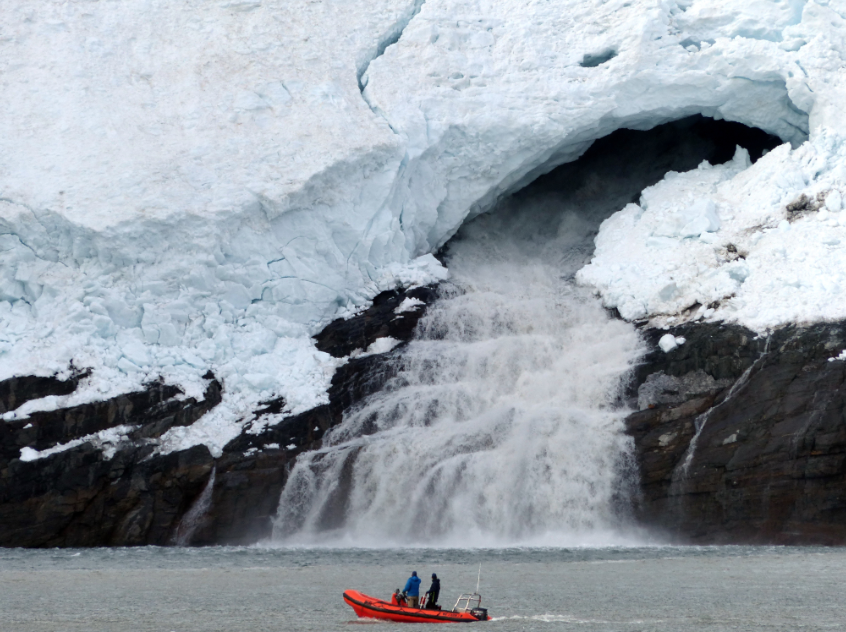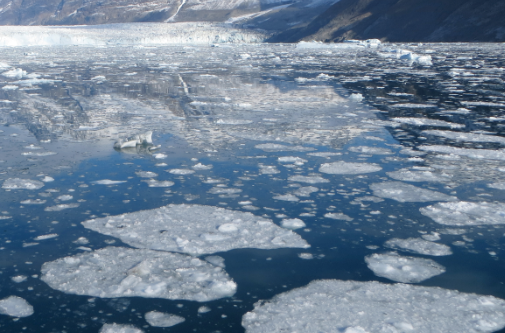story by Helen Hill

A recent multi-institutional study led by now JPL postdoc Dustin Carroll has been making use of MITgcm to explore what controls circulation in tidewater glacier fjords.
Greenland is melting, and because Greenland holds the equivalent of more than 7 m of sea level rise in its ice sheet, the race is on to understand why, and how that melting might evolve in the future – As part of this effort, Carroll et al. turned to ocean modeling to better understand the interplay between ice sheet melt and circulation in tidewater glacier fjords.
A fjord is a glacially overdeepened valley, usually narrow with steep sidewalls, which extend below sea level and fills with seawater. Tidewater glacier fjords are fjords that contain a glacier that terminates in, and calves icebergs into, the ocean. Ice sheet runoff that flows along the base of the glacier and submarine melt provide substantial buoyancy forcing at depth in tidewater glacier fjords therefore the classic models of fjord circulation can be completely reversed in these systems.
Due to a lack of sustained, full-depth measurements, oceanographers still lack a precise understanding of how circulation in Greenland’s tidewater glacier fjords is modulated by fjord-glacier geometry (i.e., fjord width, topographic constrictions, and glacier depth). Although observations are sparse, progress has been made on characterizing fjord circulation using numerical ocean models: however, previous modeling efforts have tended to be two-dimensional, focusing on systems without sills, neglecting tidal forcing, and often lacking the horizontal resolution needed to resolve cross-fjord gradients in the exchange flow. In this new study Dustin Carroll and David A. Sutherland (University of Oregon, Eugene), Emily L. Shroyer and Jonathan D. Nash (Oregon State University, Corvallis), Ginny A. Catania (University of Texas, Austen), and Leigh A. Stearns (University of Kansas, Lawrence) use MITgcm to perform a suite of idealized, high-resolution, three-dimensional, numerical ocean simulations designed to understand the dependence of fjord circulation on fjord-glacier geometry, subglacial plumes, tides, and wind stress on fjord geometry. This modeling effort complimented ocean and glacier fieldwork conducted during 2013-2015 in West Greenland.
The team base their experiments on a three-dimensional, hydrostatic, f-plane implementation of MITgcm representing the fjord as a 60 km long channel, of maximum depth 800m and variable width. The glacier terminus is treated as a vertical wall at the fjord head, with a range of glacier depths simulated. A sill at the fjord mouth connects with the western portion of the model domain (representing the coastal ocean) which takes the form of a uniform shelf of width 65 km and depth 800 m. Complete numerical details are provided in Carroll et al.
The team finds that the depth of the glacier compared to the sill is a primary control if warm coastal waters can intrude into the fjord basin. In wide fjords the plume exhibits strong lateral recirculation, increasing the dilution and residence time of glacially-modified waters.
They observe that rapid drawdown of basin waters by the subglacial plume in narrow fjords allows for shelf waters to cascade deep into the basin while wide fjords result in a thin, boundary current of shelf waters that flow toward the terminus slightly below sill depth.
Exploring the role of wind, the researchers find that wind forcing amplifies the plume-driven exchange flow but that the wind-induced vertical mixing remains limited to near-surface waters.
With regard to tides, the team found that tidal mixing over the sill increases in-fjord transport of deep shelf waters and erodes basin stratification above the sill depth.
Taken together Carroll et al. note that their results provide a framework for understanding how fjord-glacier geometry controls circulation in tidewater glacier fjords and, thus, ocean heat transport to the ice sheet.
Movies
This movie shows the plume-driven circulation in two fjords, one with a shallow glacier and one with a deep glacier that is grounded below the sill depth. The deep glacier is able to draw shelf waters over the sill and into the fjord basin, while the shallow glacier is not – animation credit: D. Carroll
This movie shows the difference in plume circulation between a 2-km and 10-km wide fjord. In the wide fjord, rotational effects result in increased mixing and recirculation cells – animation credit: D. Carroll
This movie shows the effect of tides in a 2-km and 10-km wide fjord. In the wide fjord, tide-sill interactions result in internal Kelvin waves that propagate around the fjord and increase the advection of shelf waters in the basin – animation credit: D. Carroll
This movie shows the effect of tides in a 2-km and 10-km wide fjord (as above) but here in plan view looking down the fjord. In the wide fjord, tide-sill interactions result in internal Kelvin waves that propagate around the fjord and increase the advection of shelf waters in the basin – animation credit: D. Carroll
About the Researcher
Dustin Carroll is a coastal physical oceanographer who uses observations and state-of-the-art numerical ocean models seeking a better understanding of how freshwater, ice, and carbon systems interact with the coastal ocean. He holds a PhD in Earth Science (Physical Oceanography) from the University of Oregon (2017) and is now a Caltech Postdoctoral Scholar at JPL. When he isn’t busy trying to understand how fjords work he enjoys When he isn’t busy trying to understand how fjords work he enjoys surfing, hiking with his wife and dog, and playing guitar.
This Month’s Featured Publication
- Dustin Carroll, David A. Sutherland, Emily L. Shroyer, Jonathan D. Nash, Ginny A. Catania, Leigh A. Stearns (2017), Subglacial discharge-driven renewal of tidewater glacier fjords, Journal of Geophysical Research – Oceans, Volume 122, Issue 8, Pages 6611–6629, doi: 10.1002/2017JC012962
Other New Publications this Month
Liam Brannigan, Helen Johnson, Camille Lique, Jonas Nycander and Johan Nilsson (2017), Generation of sub-surface anticyclones at Arctic surface fronts due to a surface stress, Journal of Physical Oceanography, doi: 10.1175/JPO-D-17-0022.1
Cilan Cai, Eric Rignot, Dimitris Menemenlis, Yoshihiro Nakayama (2017), Observations and modeling of ocean-induced melt beneath Petermann Glacier Ice Shelf in northwestern Greenland, Geophysical Research Letters, doi: 10.1002/2017GL073711
Annie Foppert (2017), Southern Ocean Eddy Heat Flux and Eddy-Mean Flow Interactions in Drake Passage, University of Rhode Island, doctoral dissertation
Annie Foppert, Kathleen A. Donohue, D. Randolph Watts, Karen L. Tracey (2017), Eddy heat flux across the Antarctic Circumpolar Current estimated from sea surface height standard deviation, Volume 122, Issue 8, Pages 6947–6964, doi: 10.1002/2017JC012837
Lucas Gloege, Galen A. McKinley, Colleen B. Mouw, Audrey B. Ciochetto (2017), Global evaluation of particulate organic carbon flux parameterizations and implications for atmospheric pCO2, Global Biogeochemical Cycles, Volume 31, Issue 7, Pages 1192–1215, doi: 10.1002/2016GB005535
Eliza M.-R. Kempton, Jacob L. Bean, and Vivien Parmentier (2017), An Observational Diagnostic for Distinguishing between Clouds and Haze in Hot Exoplanet Atmospheres, The Astrophysical Journal – Letters, Volume 845, No 2, doi: 10.3847/2041-8213/aa84ac
Robert H. Nazarian and Sonya Legg (2017), Internal wave scattering in continental slope canyons, part 1: Theory and development of a ray tracing algorithm, Ocean Modelling, Volume 118, October 2017, Pages 1-15, doi: 10.1016/j.ocemod.2017.07.002
Robert H. Nazarian and Sonya Legg (2017), Internal wave scattering in continental slope canyons, Part 2: A comparison of ray tracing and numerical simulations, Ocean Modelling Volume 118, October 2017, Pages 16-30, doi: 10.1016/j.ocemod.2017.07.005
Darren J. Pilcher, Galen A. McKinley, James Kralj, Harvey A. Bootsma, Euan D. Reavie (2017), Modeled sensitivity of Lake Michigan productivity and zooplankton to changing nutrient concentrations and quagga mussels, Journal of Geophysical Research – Biogeosciences, Volume 122, Issue 8, Pages 2017–2032, doi: 10.1002/2017JG003818
A Reintges, M Latif, W Park (2017), Sub-decadal variability of the North Atlantic Oscillation in observations and the Kiel Climate Model, CLIVAR Exchanges No. 71 p. 12
D.V. Stepanov (2017), Eddy energy sources and mesoscale eddies in the Sea of Okhotsk, Ocean Dynamics, ArXiv: 1708.07251
A. Verdy, M. R. Mazloff (2017), A data assimilating model for estimating Southern Ocean biogeochemistry, Journal of Geophysical Research – Oceans, doi: 10.1002/2016JC012650
Rike Völpel, André Paul, Annegret Krandick, Stefan Mulitza, and Michael Schulz (2017), Stable water isotopes in the MITgcm, Geosci. Model Dev., 10, 3125-3144, doi: 10.5194/gmd-10-3125-2017
Xianming Zhang, Yanxu Zhang, Clifton Dassuncao, Rainer Lohmann, Elsie M. Sunderland (2017), North Atlantic Deep Water formation inhibits high Arctic contamination by continental perfluorooctane sulfonate discharges, Global Biogeochemical Cycles, Volume 31, Issue 8, Pages 1332–1343, doi: 10.1002/2017GB005624
Do you have news about research using MITgcm? We are looking for contributions to these pages. If you have an interesting MITgcm project (ocean, atmosphere, sea-ice, physics, biology or otherwise) that you want to tell people about, get in touch. To make a post, contact Helen



